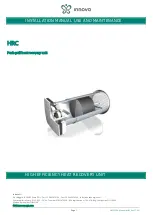
the same distance from the front and
side walls so that reflections, and
therefore changes to the frequency
response, are similar. Smaller objects,
such as equipment racks also cause
reflections and disturb the imaging,
so they too should be placed sym-
metrically in the room.
To avoid differences in low frequency
responses due to reflections from the
front wall, the monitors should be
placed either nearer than 1m or fur-
ther than 3m from the front wall. Place-
ment close to the front wall (<1m) will
boost low frequencies, and the tone
controls should be adjusted appro-
priately (see figure 6).
The monitors should be aimed toward
the listening position. This maximiz-
es the ratio of direct sound to reflect-
ed sound and the listener is able to
hear more of the material and less of
the room effects. Subjectively this is
perceived as cleaner sound and su-
perior imaging.
6. Maintenance
6. Maintenance
6. Maintenance
6. Maintenance
6. Maintenance
There are no user serviceable parts in
the unit. Maintenance or repair of the
S30D units may only be done by qual-
ified service personnel.
7. T
7. T
7. T
7. T
7. Trrrrroubleshooting
oubleshooting
oubleshooting
oubleshooting
oubleshooting
To help you solve any problems, here
are a few pointers:
• Make sure that your audio
signal source has been set
to transmit the audio to the AES/
EBU output.
• Make sure the digital cables are
specified for use with AES/EBU
digital audio signals and properly
connected at both ends.
• Make sure the LED turns yellow
as you plug in the digital audio ca-
ble to the S30D unit. If this is not
the case, go back to your audio
source and check once more that
the right output is selected. If the
LED stays green you do not have
a valid digital audio carrier on the
cable.
• If you see the LED flashing red
colour, check your cabling. Red co-
lour indicates a bit error in trans-
mission.
8. Safety considerations
8. Safety considerations
8. Safety considerations
8. Safety considerations
8. Safety considerations
Genelec S30D has been designed in
accordance with international safety
standards. To ensure safe operation
and to maintain the instrument in safe
operating condition, the following
warnings and cautions must be ob-
served:
• Servicing and adjustment may
only be performed by qualified
service personnel.
• Do not use this product with an
unearthed mains cable as this may
compromise electrical safety.
• This equipment is capable of pro-
ducing sound pressure levels in
excess of 85 dB, which may cause
permanent hearing damage.
• Free flow of air behind the loud-
speaker is necessary to maintain
sufficient cooling. Do not obstruct
airflow around the loudspeakers.
• Do not insert any objects through
the bass reflex port(s) on the face
of the unit, as this may damage the
drive units inside the loudspeaker.
• Do not run an analog audio sig-
nal to the digital input XLR connec-
tor. Doing so may overload your
audio equipment output and cause
them permanent damage.
9. Guarantee
9. Guarantee
9. Guarantee
9. Guarantee
9. Guarantee
This product is guaranteed for a pe-
riod of ONE year against faults in ma-
terials or workmanship. Refer to sup-
plier for full sales and guarantee
terms.
Figure 7. The effect of 'treble tilt', 'bass tilt' and 'bass roll-off'
controls in free field.
Figure 8. Horizontal directivity characteristics and power
response of S30D in its vertical configuration measured at 1m in
free field.
75
80
85
20
20k
50
100
200
500
1k
2k
5k
10k
Hz
80
85
90
80
85
90
90
BASS ROLL-OFF
BASS TILT
BASS LEVEL
MIDRANGE LEVEL
TREBLE LEVEL
S30D 19.1.2000
Mic. B&K 4133 1/2"
dBr
50
55
60
65
70
75
80
85
90
95
20
20k
50
100
200
500
1k
2k
5k
10k
60°
45°
0°
30°
15°
S30D 19.1.2000
Mic. B&K 4133 1/2"
Hz
dBr
50
55
60
65
70
100k
10k
20k
30k
40k
50k
60k 70k 80k
Hz
S30D 19.1.2000
Mic. B&K 4135 1/4"
dBr
Figure 9. The on-axis free field response of the S30D between
10 and 100 kHz.
























